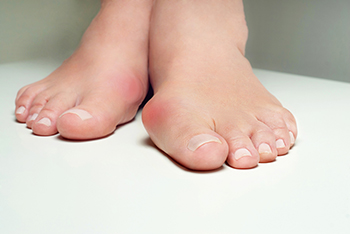
A bunion can form on the side of the big toe as a result of wearing shoes that do not have ample room for the toes to move freely in. High heels can fall into this category, and it is beneficial to choose shoes that have a square toe area. Bunions can be painful and may cause the other toes to shift toward each other. The symptoms can include redness surrounding the bunion, and corns or calluses may form on top of it as it touches the shoe. Some people may experience numbness or sharp pains, which can come from existing nerve damage. Research has indicated that bunions are rare in people whose cultures deem it normal to routinely walk barefoot for the majority of the day, as the feet are not confined in tight shoes. Many people find mild relief when a protective pad is placed over the bunion, and larger shoes are worn. If you have developed a bunion, it is strongly suggested that you visit a podiatrist who can offer treatment options that are correct for you, which may include surgery for permanent removal.
If you are suffering from bunions, contact Dr. John R. Northrup of Superior Foot, Ankle & Wound Care. Our doctors can provide the care you need to keep you pain-free and on your feet.
What Is a Bunion?
A bunion is formed of swollen tissue or an enlargement of boney growth, usually located at the base joint of the toe that connects to the foot. The swelling occurs due to the bones in the big toe shifting inward, which impacts the other toes of the foot. This causes the area around the base of the big toe to become inflamed and painful.
Why Do Bunions Form?
Genetics – Susceptibility to bunions are often hereditary
Stress on the feet – Poorly fitted and uncomfortable footwear that places stress on feet, such as heels, can worsen existing bunions
How Are Bunions Diagnosed?
Doctors often perform two tests – blood tests and x-rays – when trying to diagnose bunions, especially in the early stages of development. Blood tests help determine if the foot pain is being caused by something else, such as arthritis, while x-rays provide a clear picture of your bone structure to your doctor.
How Are Bunions Treated?
- Refrain from wearing heels or similar shoes that cause discomfort
- Select wider shoes that can provide more comfort and reduce pain
- Anti-inflammatory and pain management drugs
- Orthotics or foot inserts
- Surgery
If you have any questions, please feel free to contact one of our offices located in St. Augustine, and Palm Coast, FL . We offer the newest diagnostic and treatment technologies for all your foot care needs.
